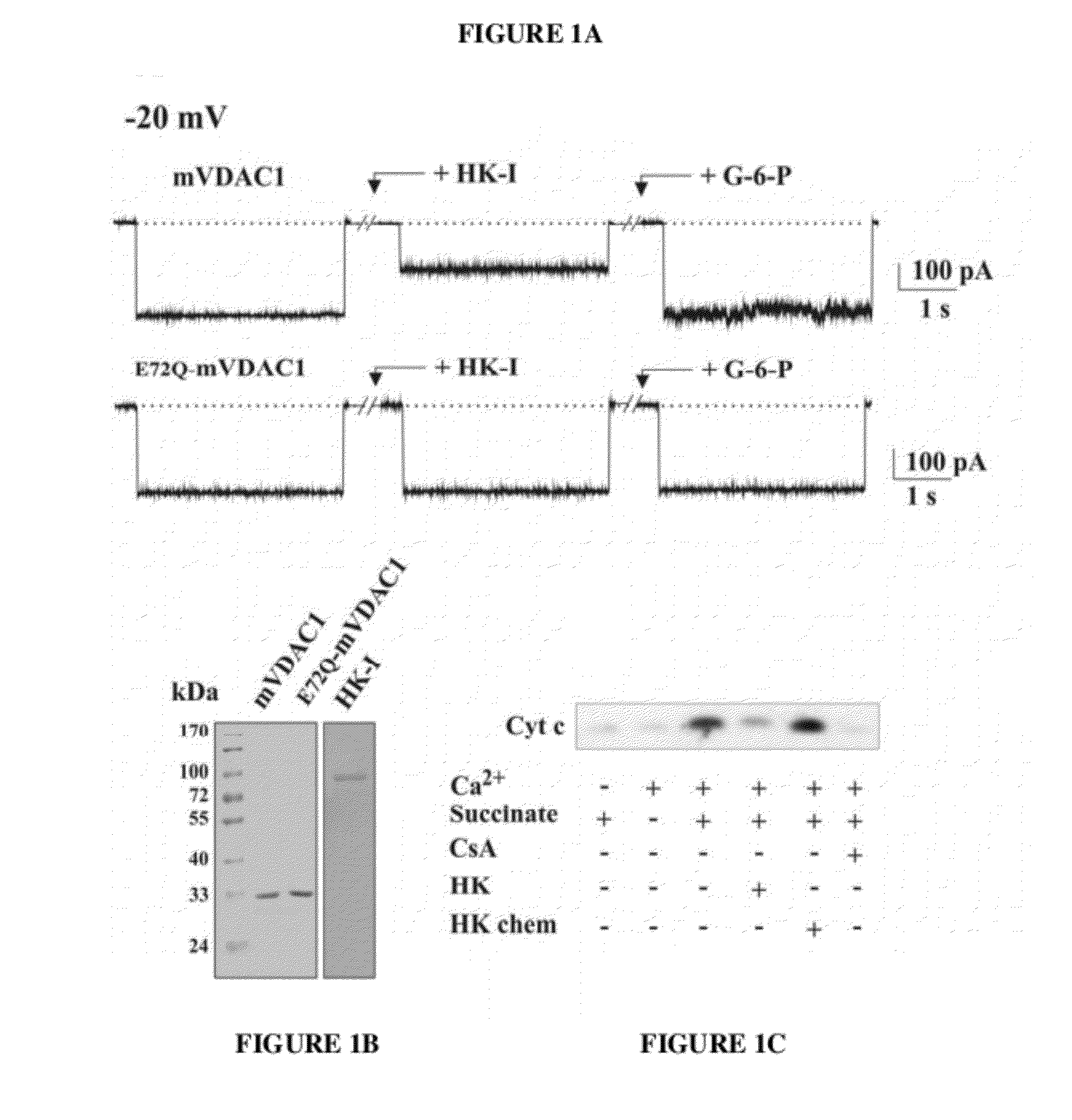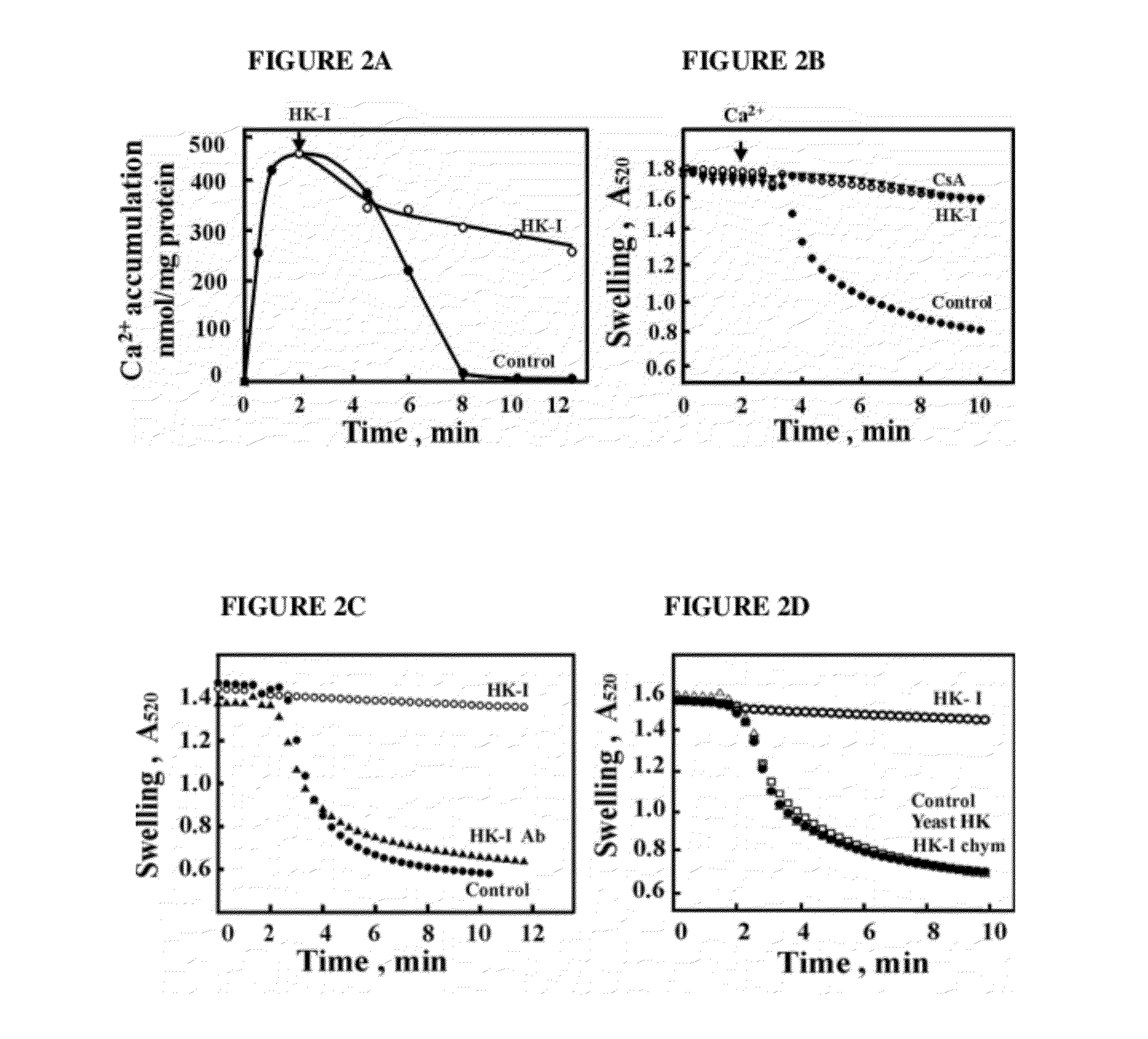VDAC1 compositions and methods of use thereof for regulating apoptosis
a voltage-dependent anion channel and apoptosis technology, applied in the field of vdac1 compositions and methods of use thereof, can solve the problems of inherent resistance or acquired resistance in cancer chemotherapy, and achieve the effect of enhancing the effect of an apoptosis-inducing reagent and inducing cell apoptosis
- Summary
- Abstract
- Description
- Claims
- Application Information
AI Technical Summary
Benefits of technology
Problems solved by technology
Method used
Image
Examples
example 1
Mapping of the Protein-Protein Docking Surfaces in VDAC1
[0221]Recently, two domains of VDAC1 that are required for HK-I protection against cell death were identified. Using deletion analysis and site-directed mutagenesis of VDAC1, key contact surfaces on VDAC1 that are essential in its interaction with anti-apoptotic proteins were mapped. VDAC1 mutants were analyzed at the level of purified proteins reconstituted into planar lipid bilayers, isolated mitochondria and in cell culture, where the biological effects of the mutations on induction of apoptosis and protection against apoptosis by HK-I were determined.
[0222]The results presented herein in FIG. 1 show that HK-I interacts directly with VDAC1 and induces its closure. FIGS. 1A-1C show that HK-I is able to close native VDAC1 but not mutated E72Q-VDAC1 (SEQ ID NO:43). FIG. 1A: Purified recombinant native or E72Q-mutated mVDAC1 was reconstituted into a PLB (planar lipid bilayer) in symmetrical solutions of 0.5 M NaCl. Currents thro...
example 2
HK-I Prevents PTP Opening and Release of Cytochrome C
[0223]FIG. 2 shows the effects of HK-I on PTP opening, as monitored by Ca2+ accumulation and swelling of energized mitochondria, and by release of cytochrome c. HK-I inhibited PTP opening and this inhibition was prevented by an antibody specific to the N-terminal of HK-I (FIG. 2C). The failure of non-binding species of HK, such as yeast HK, or trypsin- or chymotrypsin-treated HK-I (FIG. 2D) to prevent PTP opening, confirmed the specificity of the HK-I effect, and of the requirement of the HK-I N-terminal region for its interaction with VDAC.
[0224]HK-I prevented the release of cytochrome c from mitochondria (as revealed by Western blot analysis, FIG. 1C). The effects of HK-I are similar to those of the well-known inhibitor of PTP, cyclosporine A (CsA) (FIGS. 1C and 2B).
example 3
HK-I Over-Expression Protects Against Apoptotic Cell Death Induced by Over-Expression of Native and Some VDAC1 Variants, but not of E72Q- and E65Q-mVDAC1
[0225]Leukemic U937 cells were transformed to express green fluorescent protein (GFP) and VDAC1-GFP. While cells expressing GFP showed diffuse green fluorescence, cells expressing VDAC1-GFP showed mainly punctuated fluorescence confined to membranes (FIG. 3A). Immunoblot analysis of cell extracts using anti-VDAC or anti-GFP antibodies confirmed the expression of VDAC1-GFP (FIG. 3B). It is noteworthy that the fused VDAC1-GFP was highly protease-sensitive and was readily cleaved to VDAC1 and GFP, as reflected in the appearance of GFP in the VDAC1-GFP expressing cells (FIG. 3B). As shown, in cells transfected to stably over-express HK-I, with and without a second transfection with mVDAC1-GFP or E72Q-mVDAC1-GFP, the level of HK-I was about 3-4-fold higher than in HK-I non-transfected cells
[0226]The effect of HK-I over-expression on apop...
PUM
| Property | Measurement | Unit |
|---|---|---|
| Tm | aaaaa | aaaaa |
| Tm | aaaaa | aaaaa |
| Tm | aaaaa | aaaaa |
Abstract
Description
Claims
Application Information
 Login to View More
Login to View More - R&D
- Intellectual Property
- Life Sciences
- Materials
- Tech Scout
- Unparalleled Data Quality
- Higher Quality Content
- 60% Fewer Hallucinations
Browse by: Latest US Patents, China's latest patents, Technical Efficacy Thesaurus, Application Domain, Technology Topic, Popular Technical Reports.
© 2025 PatSnap. All rights reserved.Legal|Privacy policy|Modern Slavery Act Transparency Statement|Sitemap|About US| Contact US: help@patsnap.com



